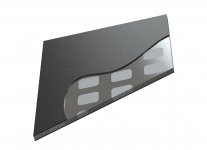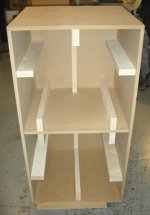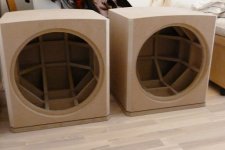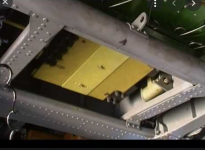f you compare an alu speaker shell to a ply shell made with identical dimensions - like 1cm thick walls - then yes.
The 120kg alu box will be stiffer then the 30kg ply box.
This is the correct way to look at this comparison.
In general, for a given geometric shape (panel, dome, cone, hollow cube, etc), the first mode resonance frequency is dependent on the specific stiffness. In other words, the stiffness divided by the density, or in more common terms, the stiffness to weight ratio. So for aluminum it would be the Young's modulus divided by the density... 70 (GPa)/2700 (kg/m^3) = 26 x 10^6 m^2/s^2. Other materials have other values, but aluminum has a pretty darn good stiffness to weight ratio. So does titaniun. Carbon epoxy is very good, and beryllium is quite excellent. Wood is very good also, and wood fibers pressed into a "paper" as used in speaker cones, is very good also.
The dependence of the first mode resonance to the stiffness/weight ratio can be a linear dependence in the case of a simple round cantilevered beam, but it can be non-linear for complex shapes. A truss for example, gets almost all if its stiffness from its geometry. Changing from a moderate stiffness/weight material like to a high stiffness/weight material does not affect the resonance frequency as much as you might expect.
Given the bracing strategies we often use for speaker cabinets, it is "hard" to predict what the resonance frequency would be for a cabinet... by "hard" I mean nearly impossible.
In practice, heaps of mundane stuff - like moving from one chair to another - has a much bigger effect on the bass / sound quality I get.
After a basic quality level is met, it is probably better to look at everything else - dispersion pattern, EQ, room optimisation and so on, rather than to obsess about whether your cabinet materials are hyper premium enough.
Yeah... this thread has been fun and entertaining to read... but the truth is that good speakers sound good for a lot of reasons, but a massively complex esoteric cabinet construction is not one of those reasons. And a speaker with an uber-stiff and uber-damped cabinet but with offensive on-axis and off-axis behavior will sound bad. The heroic cabinet does nothing to redeem the poor fellow.
On the other hand, discovering a bad cabinet resonance after the speaker has been built is very discouraging. It is a hard problem to fix after the box is built. We can adjust a crossover quite easilly, but reducing a structural resonance is can be very hard. So most people, including me, tend to go "above and beyond" when making cabinets.
Is it possible to cover the whole spectrum, high spl, low distortion with a 2-way?
^^pics of my bracing^^
The reason why I like this style bracing is because the long panels serve to break up (divide/raise) resonate modes. I borrowed from Bills approach, brace spacing. The added mass is welcome for obvious reasons. I used three-quarter inch plywood for the bracing... in the areas where a cross brace can't fit rib bracing is the second best... so they say...
^^pics of my bracing^^
The reason why I like this style bracing is because the long panels serve to break up (divide/raise) resonate modes. I borrowed from Bills approach, brace spacing. The added mass is welcome for obvious reasons. I used three-quarter inch plywood for the bracing... in the areas where a cross brace can't fit rib bracing is the second best... so they say...
Last edited:
Camplo, what do you cal ribbs bracing please ? Is it a wood piece glued on the internal baffles only or the a wood piece glued on two facing baffles to couple them ?
I'm wondering as well if the bracing has not an equal importance for dividing the energy that comes back into the inside of the cone/dome by a longer delay, so less feedback movement on the cone, and some maybe less of parasitic motional energy in the voice coil ? Just guessing 😕
The thing I try to keep in mind reading all the numerous threads on the subject is to remove the resonance where it arms the most : if I understood correctly, the famous sound box is very unpleasant in the 100 to 400 hz.
I assume an heavy loudspeaker, stiff enough for all the baffles don't sing will push the said resonances below that 100 hz to 400 hz while the lighter and not damped enough will try to push it above : we often read: more than 700 hz, BBC style. I surmise the second strategy to be more hasardous while the heaviest cabinet with material which don't damp by internal loss will anyway need a lot of bracing and foam/wool to fulfill the internal space to help the cone/dome not to be excited too much ! That's not a myth than cone with a sandwich structure, often with a light foam in the middle, push the harmonics very low.
As is saying HifiJim, you need both stiffness and damping which is opposite so a ratio in a standalone material : hence sandwich constructions are a good bet and not expensive as the internal has not to be beautiful. Complex shapes when inside have some, I surmise, the same goal than bracing : breaking the internal room modes and "flutter echos" (don't know if it is the right word?) into several of a less amplitude ! Quite an interesting subject but to rephrase what is already said : I'm sure if my diy loudspeaker will sound bad, the culprit will be more the lack of skill in the whole design : filter, load, knowledge than the box itself.
Wood ik ok, aluminum certainly good enough if you want to be made like that ! At equal TCO, I prefer to putt the money more in the drivers and passive filter quality if the skill is good enough for that to make the difference with them. No Cost object, I prefer directly to go to a loudspeaker shop 😀 ! Secondhand loudspeakers makes my wallet often stiffer and better damped too but that OT !
I'm wondering as well if the bracing has not an equal importance for dividing the energy that comes back into the inside of the cone/dome by a longer delay, so less feedback movement on the cone, and some maybe less of parasitic motional energy in the voice coil ? Just guessing 😕
The thing I try to keep in mind reading all the numerous threads on the subject is to remove the resonance where it arms the most : if I understood correctly, the famous sound box is very unpleasant in the 100 to 400 hz.
I assume an heavy loudspeaker, stiff enough for all the baffles don't sing will push the said resonances below that 100 hz to 400 hz while the lighter and not damped enough will try to push it above : we often read: more than 700 hz, BBC style. I surmise the second strategy to be more hasardous while the heaviest cabinet with material which don't damp by internal loss will anyway need a lot of bracing and foam/wool to fulfill the internal space to help the cone/dome not to be excited too much ! That's not a myth than cone with a sandwich structure, often with a light foam in the middle, push the harmonics very low.
As is saying HifiJim, you need both stiffness and damping which is opposite so a ratio in a standalone material : hence sandwich constructions are a good bet and not expensive as the internal has not to be beautiful. Complex shapes when inside have some, I surmise, the same goal than bracing : breaking the internal room modes and "flutter echos" (don't know if it is the right word?) into several of a less amplitude ! Quite an interesting subject but to rephrase what is already said : I'm sure if my diy loudspeaker will sound bad, the culprit will be more the lack of skill in the whole design : filter, load, knowledge than the box itself.
Wood ik ok, aluminum certainly good enough if you want to be made like that ! At equal TCO, I prefer to putt the money more in the drivers and passive filter quality if the skill is good enough for that to make the difference with them. No Cost object, I prefer directly to go to a loudspeaker shop 😀 ! Secondhand loudspeakers makes my wallet often stiffer and better damped too but that OT !
Last edited:
"you need both stiffness and damping which is opposite"
That kinda sums up the paradox of stiffness working against itself, from what I'm reading at least. Very stiff apparently will equate to a "high Q" behavior, which does make sense, and this is a very "aluminumy" quality. But the density, i.e. heavy, issue with aluminum (as compared to wood) should be what serves to dampen it and reign in that high Q. When you get into laminates and that massive modulus advantage gets watered down with Al vs. plywood, aluminum doesn't make as much sense. When a monolithic slab of Al is used, which is obviously heavyish, that seems like the more sensible application. In that scenario you have mass and stiffness working for you. The Magico A1 is a good example with a simple construction and moderately beefy billet Al plates.
My natural inclination is to have everything as light as possible, mainly for transportability reasons. A carbon/core laminate is about the best way to practically do this. Beryllium would be fun but that's way too exotic. But as has been pointed out, whatever the strategy, it may or may not perform as advertised.
Back to the damping vs. stiffness paradox; I wonder if skinning solid slabs of aluminum with sheets of carbon would be a killer combo. The carbon laminates would bring the modulus up to near steel levels; very freaking high. Yet the comparatively heavy billet would act as damping, taking aluminum to the next level. If the mass of the aluminum is not enough to keep up with the boosted Young's modulus, maybe a grid of gray iron vibe-absorbers (helicopter style) could be added.
Using carbon honeycomb sandwich construction is not entirely rare. But perhaps carbon/Al-monolith would be a more killer application? I want to go lightweight. Now if you can get aluminum to perform like steel, but at aluminum weight, then I would consider that to fit the lightweight definition. Just thinking out loud-
That kinda sums up the paradox of stiffness working against itself, from what I'm reading at least. Very stiff apparently will equate to a "high Q" behavior, which does make sense, and this is a very "aluminumy" quality. But the density, i.e. heavy, issue with aluminum (as compared to wood) should be what serves to dampen it and reign in that high Q. When you get into laminates and that massive modulus advantage gets watered down with Al vs. plywood, aluminum doesn't make as much sense. When a monolithic slab of Al is used, which is obviously heavyish, that seems like the more sensible application. In that scenario you have mass and stiffness working for you. The Magico A1 is a good example with a simple construction and moderately beefy billet Al plates.
My natural inclination is to have everything as light as possible, mainly for transportability reasons. A carbon/core laminate is about the best way to practically do this. Beryllium would be fun but that's way too exotic. But as has been pointed out, whatever the strategy, it may or may not perform as advertised.
Back to the damping vs. stiffness paradox; I wonder if skinning solid slabs of aluminum with sheets of carbon would be a killer combo. The carbon laminates would bring the modulus up to near steel levels; very freaking high. Yet the comparatively heavy billet would act as damping, taking aluminum to the next level. If the mass of the aluminum is not enough to keep up with the boosted Young's modulus, maybe a grid of gray iron vibe-absorbers (helicopter style) could be added.
Using carbon honeycomb sandwich construction is not entirely rare. But perhaps carbon/Al-monolith would be a more killer application? I want to go lightweight. Now if you can get aluminum to perform like steel, but at aluminum weight, then I would consider that to fit the lightweight definition. Just thinking out loud-
Last edited:
That kinda sums up the paradox of stiffness working against itself,
From my humble perspective...Q is somewhat complex and gets used a few different ways, so forgive me if I mix it up.
Q=compliance is highest at the resonate note. Period. and lowers above and below
So if you raise stiffness....the resonate note goes up in frequency and compliance goes down. Q going up with stiffness is really a misnomer without the designation of the fact that we are no longer talking about mechanical compliance.
Q going up in that sense (as you are referring to it), refers to the shape of the resulting frequency response of the material resonance.... in the same sense that you see "Q" as an adjustment on an parametric equalizer....this compliance has to do with the willingness of a frequency response to be manipulated by a filter or input via resonance....thus a Filter or frequency response with a high Q will create a sharp and narrow peak ...and a filter with a low Q will create a wide smooth mound....
I could try to use more words but a pic says 1000.....
So once again, the literal mechanical compliance (the ability of an object to yield elastically when a force is applied : FLEXIBILITY) of a material actually goes down with rigidity.....and though the Q of the response to the resonant goes up....the fact remains that the energy transfer is much less efficient at the resonant note resulting in less resounding....
Attachments
Last edited:
Camplo, what do you cal ribbs bracing please ?
Think of a rib as a cross brace that is riding against one of the baffles
Attachments
I think there is two types of cabinet resonance we are talking about here. With very different mechanisms. The first one is the low frequency type resonance caused by massive pressure during bass. Solution is stiffness and bracing to give it less likely to buckle. Or building cylindrical shapes.
The second type is ringing, low amplitude, high frequency stuff. Not common in wood as they are naturally damped. These need damping for high modulus material with some viscoelastic material.... bitumen pad. Or better still constrained later damping. I once encountered a chopping board with a piece of rubber sandwiched between two wood.... It was very quiet...
Oon
The second type is ringing, low amplitude, high frequency stuff. Not common in wood as they are naturally damped. These need damping for high modulus material with some viscoelastic material.... bitumen pad. Or better still constrained later damping. I once encountered a chopping board with a piece of rubber sandwiched between two wood.... It was very quiet...
Oon
I think if you can find honeycomb metal structures for stiffness added with bracing and use a car dampening pad, it would make a nice lightweight and quite speaker cabinet.
Here is what constrained layer damping does.
Constrained layer damping. Impressive. - YouTube
Oon
Here is what constrained layer damping does.
Constrained layer damping. Impressive. - YouTube
Oon
According to Bill, this is the most effective bracing strategy per mass...
I personally say, science/nature agrees...the structure of bird bones comply.
I said
and one of the his protégées said
Bill does...
Never said/implied it wasn't, just way overkill like 99.9 % of the DIY bracing I've been exposed to.
You want to compare it to bird construction? Pick one up after it's flown into a window pane, it's more mush than intact IME, so not a valid example.
Again, haven't said anything re driver vibration and if you go searching and find all the times I've been involved with this subject I tell folks that they need to tie all six sides together to keep it from 'breathing', so you're 'preaching to the choir' here.
I think if you can find honeycomb metal structures for stiffness added with bracing and use a car dampening pad, it would make a nice lightweight and quite speaker cabinet.
Here is what constrained layer damping does.
Constrained layer damping. Impressive. - YouTube
Oon
If the box is flexing, even if its not ringing, its not desirable, and CLD doesn't prevent this. You'll end up with a box that vibrates though it does not continue to do so after the source stops....WE don't want just a stiff box we want an Inert box...big difference.
Well, I want a stiff box that 'rings' either far enough above or below the speaker's usable BW, so it can't be excited, ergo technically inert, but not your 'Inert.'
"If the box is flexing, even if its not ringing, its not desirable, and CLD doesn't prevent this. You'll end up with a box that vibrates though it does not continue to do so after the source stops....WE don't want just a stiff box we want an Inert box...big difference."
@camplo, you read into my use of Q correctly; I just co-opted the broad definition for lack of vernacular.
About the composite cab with CLD- oon_the_kid made a dimensionless suggestion. It could be a 2" thick aluminum honeycomb panel that would be as stiff as just about anything, or it could be flapping in the wind.
The implication is mass = damping. If a super light, super stiff cab fails to perform, it's presumably not due to being stiff. That's my assumption on the heft of aluminum as a good thing; if made to be too light it will probably resonate "wrong." Is there a consensus that ultralight cabs can't perform, regardless of rigidity? It would be a shame, as stiffness and damping are very different problems that have better separate and drastically differing solutions.
Maybe light cabs can employ some aerospace vibration management similar to the H-60 vibe-absorbers? A tuning spring, essentially-
@camplo, you read into my use of Q correctly; I just co-opted the broad definition for lack of vernacular.
About the composite cab with CLD- oon_the_kid made a dimensionless suggestion. It could be a 2" thick aluminum honeycomb panel that would be as stiff as just about anything, or it could be flapping in the wind.
The implication is mass = damping. If a super light, super stiff cab fails to perform, it's presumably not due to being stiff. That's my assumption on the heft of aluminum as a good thing; if made to be too light it will probably resonate "wrong." Is there a consensus that ultralight cabs can't perform, regardless of rigidity? It would be a shame, as stiffness and damping are very different problems that have better separate and drastically differing solutions.
Maybe light cabs can employ some aerospace vibration management similar to the H-60 vibe-absorbers? A tuning spring, essentially-
Attachments
Last edited:
whats my inert? Oh you mean the everkill thingergo technically inert, but not your 'Inert.'
Well yeah, in that example you are getting max strength per mass....Airplane wings are not braced much differentlyYou want to compare it to bird construction
Last edited:
The bracing and honeycomb structure is for the flexing. The CLD is for the ringing. If you just build a box out of honeycomb aluminium, it will probably ring....If the box is flexing, even if its not ringing, its not desirable, and CLD doesn't prevent this. You'll end up with a box that vibrates though it does not continue to do so after the source stops....WE don't want just a stiff box we want an Inert box...big difference.
Oon.
Actually the most important aspect of damping is energy loss. So, what you need is viscous and elastic material, otherwise known as viscoelastic. If you press something, it comes back slowly, like your skin it is viscoelastic. To describe this, it is like vibrating something in caramel. Butyl pads are good for this."If the box is flexing, even if its not ringing, its not desirable, and CLD doesn't prevent this. You'll end up with a box that vibrates though it does not continue to do so after the source stops....WE don't want just a stiff box we want an Inert box...big difference."
@camplo, you read into my use of Q correctly; I just co-opted the broad definition for lack of vernacular.
About the composite cab with CLD- oon_the_kid made a dimensionless suggestion. It could be a 2" thick aluminum honeycomb panel that would be as stiff as just about anything, or it could be flapping in the wind.
The implication is mass = damping. If a super light, super stiff cab fails to perform, it's presumably not due to being stiff. That's my assumption on the heft of aluminum as a good thing; if made to be too light it will probably resonate "wrong." Is there a consensus that ultralight cabs can't perform, regardless of rigidity? It would be a shame, as stiffness and damping are very different problems that have better separate and drastically differing solutions.
Maybe light cabs can employ some aerospace vibration management similar to the H-60 vibe-absorbers? A tuning spring, essentially-
However beyond a certain point, it becomes an academic discussion because the sound going through your speaker cones will be higher..
Oon
Right, build an extremely rigid box [< ~500 Hz XO] with a very high MOE to make it 'ring' at > ~ 1 kHz and either mass load it from the top or mount it on the appropriate lossy base.
@Oon, an interesting thing about viscoelastics is how they change in rigidity based in the intensity of input. I think Newtonian fluids are similar. Maybe I could fill it with ketchup! Regarding becoming academic at a certain point, that sounds good to me, implying that a lightweight cab won't really be a poor performer. I've discussed light composite builds in the past and it invariably gets much critique as if there is an insurmountable wall to a good sounding one. I dunno.
@GM, can you elaborate more on that? MOE as in modulus of elasticity, right? If I'm following, it sounds like using the inherent ring of a light/stiff panel at a desired frequency where you then clamp it down via a top weight or use a base that will soak up the resonance. Very nice little tricks!
@GM, can you elaborate more on that? MOE as in modulus of elasticity, right? If I'm following, it sounds like using the inherent ring of a light/stiff panel at a desired frequency where you then clamp it down via a top weight or use a base that will soak up the resonance. Very nice little tricks!
Last edited:
- Home
- Loudspeakers
- Multi-Way
- Aluminium speaker cabinets




